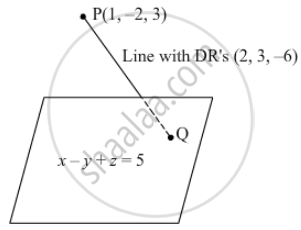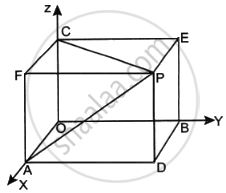Advertisements
Advertisements
प्रश्न
Find the distance of the point (1, −2, 3) from the plane x − y + z = 5 measured parallel to the line whose direction cosines are proportional to 2, 3, −6.
उत्तर
The equation of the given plane is x − y + z = 5.
We have to find the distance of point (1, −2, 3) from the plane measured parallel to line whose direction cosines are proportional to 2, 3, −6.
Let this line meet the plane at Q.
The equation of the line passing through (1,−2, 3) and having direction cosines proportional to 2, 3, −6 is

Let this line meet the plane at Q.
The equation of the line passing through (1,−2, 3) and having direction cosines proportional to 2, 3, −6 is \[\frac{x - 1}{2} = \frac{y + 2}{3} = \frac{z - 3}{- 6} = \lambda\]
\[\Rightarrow x = 2\lambda + 1, y = 3\lambda - 2, z = - 6\lambda + 3\]
So, the coordinates of any point on the line are in the form \[\left( 2\lambda + 1, 3\lambda - 2, - 6\lambda + 3 \right)\]
If this point \[\left( 2\lambda + 1, 3\lambda - 2, - 6\lambda + 3 \right)\] lies on the plane x − y + z = 5, then \[2\lambda + 1 - 3\lambda + 2 - 6\lambda + 3 = 5\]
\[\Rightarrow - 7\lambda + 6 = 5\]
\[\Rightarrow - 7\lambda = - 1\]
\[\Rightarrow \lambda = \frac{1}{7}\]
Therefore, the coordinates of point Q are
\[\left( \frac{2}{7} + 1, \frac{3}{7} - 2, - \frac{6}{7} + 3 \right)\] i.e.
\[\left( \frac{9}{7}, - \frac{11}{7}, \frac{15}{7} \right)\] .
Using distance formula, we have
PQ = \[\sqrt{\left( \frac{9}{7} - 1 \right)^2 + \left( - \frac{11}{7} + 2 \right)^2 + \left( \frac{15}{7} - 3 \right)^2}\]
= \[\sqrt{\left( \frac{2}{7} \right)^2 + \left( \frac{3}{7} \right)^2 + \left( - \frac{6}{7} \right)^2}\]
= \[\sqrt{\frac{4}{49} + \frac{9}{49} + \frac{36}{49}}\]
= \[\sqrt{\frac{49}{49}}\]
= 1
APPEARS IN
संबंधित प्रश्न
Show that the points (1, 1, 1) and (-3, 0, 1) are equidistant from the plane `bar r (3bari+4barj-12bark)+13=0`
Find the equation of the planes parallel to the plane x + 2y+ 2z + 8 =0 which are at the distance of 2 units from the point (1,1, 2)
Find the distance of a point (2, 5, −3) from the plane `vec r.(6hati-3hatj+2 hatk)=4`
Find the equation of the plane through the line of intersection of the planes x + y + z = 1 and 2x + 3y + 4z = 5 which is perpendicular to the plane x − y + z = 0. Also find the distance of the plane, obtained above, from the origin.
In the given cases, find the distance of each of the given points from the corresponding given plane.
Point Plane
(0, 0, 0) 3x – 4y + 12 z = 3
In the given cases, find the distance of each of the given points from the corresponding given plane.
Point Plane
(2, 3, – 5) x + 2y – 2z = 9
In the given cases, find the distance of each of the given points from the corresponding given plane.
Point Plane
(– 6, 0, 0) 2x – 3y + 6z – 2 = 0
Find the distance of the point (−1, −5, −10) from the point of intersection of the line `vecr = 2hati -hatj + 2hatk + lambda(3hati + 4hatj + 2hatk)` and the plane `vecr.(hati -hatj + hatk) = 5`.
Distance between the two planes: 2x + 3y + 4z = 4 and 4x + 6y + 8z = 12 is
(A) 2 units
(B) 4 units
(C) 8 units
(D)`2/sqrt29 "units"`
Show that the points (1, –1, 3) and (3, 4, 3) are equidistant from the plane 5x + 2y – 7z + 8 = 0
Find the distance of the point (1, 2, –1) from the plane x - 2y + 4z - 10 = 0 .
Write the equation of a plane which is at a distance of \[5\sqrt{3}\] units from origin and the normal to which is equally inclined to coordinate axes.
Find the distance of the point \[2 \hat{i} - \hat{j} - 4 \hat{k}\] from the plane \[\vec{r} \cdot \left( 3 \hat{i} - 4 \hat{j} + 12 \hat{k} \right) - 9 = 0 .\]
Find the distance of the point (2, 3, −5) from the plane x + 2y − 2z − 9 = 0.
Find the equations of the planes parallel to the plane x + 2y − 2z + 8 = 0 that are at a distance of 2 units from the point (2, 1, 1).
Show that the points (1, 1, 1) and (−3, 0, 1) are equidistant from the plane 3x + 4y − 12z + 13 = 0.
Find the distance of the point (3, 3, 3) from the plane \[\vec{r} \cdot \left( 5 \hat{i} + 2 \hat{j} - 7k \right) + 9 = 0\]
If the product of the distances of the point (1, 1, 1) from the origin and the plane x − y + z+ λ = 0 be 5, find the value of λ.
Find an equation for the set of all points that are equidistant from the planes 3x − 4y + 12z = 6 and 4x + 3z = 7.
Find the distance between the parallel planes 2x − y + 3z − 4 = 0 and 6x − 3y + 9z + 13 = 0.
Find the equation of the plane which passes through the point (3, 4, −1) and is parallel to the plane 2x − 3y + 5z + 7 = 0. Also, find the distance between the two planes.
If a plane passes through the point (1, 1, 1) and is perpendicular to the line \[\frac{x - 1}{3} = \frac{y - 1}{0} = \frac{z - 1}{4}\] then its perpendicular distance from the origin is ______.
Write the coordinates of the point which is the reflection of the point (α, β, γ) in the XZ-plane.
Find the distance of the point `4hat"i" - 3hat"j" + hat"k"` from the plane `bar"r".(2hat"i" + 3hat"j" - 6hat"k")` = 21.
Find the distance of the point (1, 1 –1) from the plane 3x +4y – 12z + 20 = 0.
Solve the following:
Find the distance of the point `3hat"i" + 3hat"j" + hat"k"` from the plane `bar"r".(2hat"i" + 3hat"j" + 6hat"k")` = 21.
The perpendicular distance of the origin from the plane x − 3y + 4z = 6 is ______
The equation of the plane passing through (3, 1, 2) and making equal intercepts on the coordinate axes is _______.
The equations of planes parallel to the plane x + 2y + 2z + 8 = 0, which are at a distance of 2 units from the point (1, 1, 2) are ________.
If the foot of perpendicular drawn from the origin to the plane is (3, 2, 1), then the equation of plane is ____________.
Find the distance of the point whose position vector is `(2hat"i" + hat"j" - hat"k")` from the plane `vec"r" * (hat"i" - 2hat"j" + 4hat"k")` = 9
Find the distance of the point (– 2, 4, – 5) from the line `(x + 3)/3 = (y - 4)/5 = (z + 8)/6`
Find the coordinates of the point where the line through (3, – 4, – 5) and (2, –3, 1) crosses the plane passing through three points (2, 2, 1), (3, 0, 1) and (4, –1, 0)
A plane meets the co-ordinates axis in A, B, C such that the centroid of the ∆ABC is the point (α, β, γ). Show that the equation of the plane is `x/alpha + y/beta + z/ϒ` = 3
The distance of a point P(a, b, c) from x-axis is ______.
Distance of the point (α, β, γ) from y-axis is ____________.
The distance of the plane `vec"r" *(2/7hat"i" + 3/4hat"j" - 6/7hat"k")` = 1 from the origin is ______.
Find the equation of the plane passing through the point (1, 1, 1) and is perpendicular to the line `("x" - 1)/3 = ("y" - 2)/0 = ("z" - 3)/4`. Also, find the distance of this plane from the origin.
Find the foot of the perpendicular from the point (1, 2, 0) upon the plane x – 3y + 2z = 9. Hence, find the distance of the point (1, 2, 0) from the given plane.
Which one of the following statements is correct for a moving body?
`phi` is the angle of the incline when a block of mass m just starts slipping down. The distance covered by the block if thrown up the incline with an initial speed u0 is
The coordinates of the point on the parabola y2 = 8x which is at minimum distance from the circle x2 + (y + 6)2 = 1 are
Find the distance of the point (1, –2, 0) from the point of the line `vecr = 4hati + 2hatj + 7hatk + λ(3hati + 4hatj + 2hatk)` and the point `vecr.(hati - hatj + hatk)` = 10.
The distance of the point `2hati + hatj - hatk` from the plane `vecr.(hati - 2hatj + 4hatk)` = 9 will be ______.
In the figure given below, if the coordinates of the point P are (a, b, c), then what are the perpendicular distances of P from XY, YZ and ZX planes respectively?

